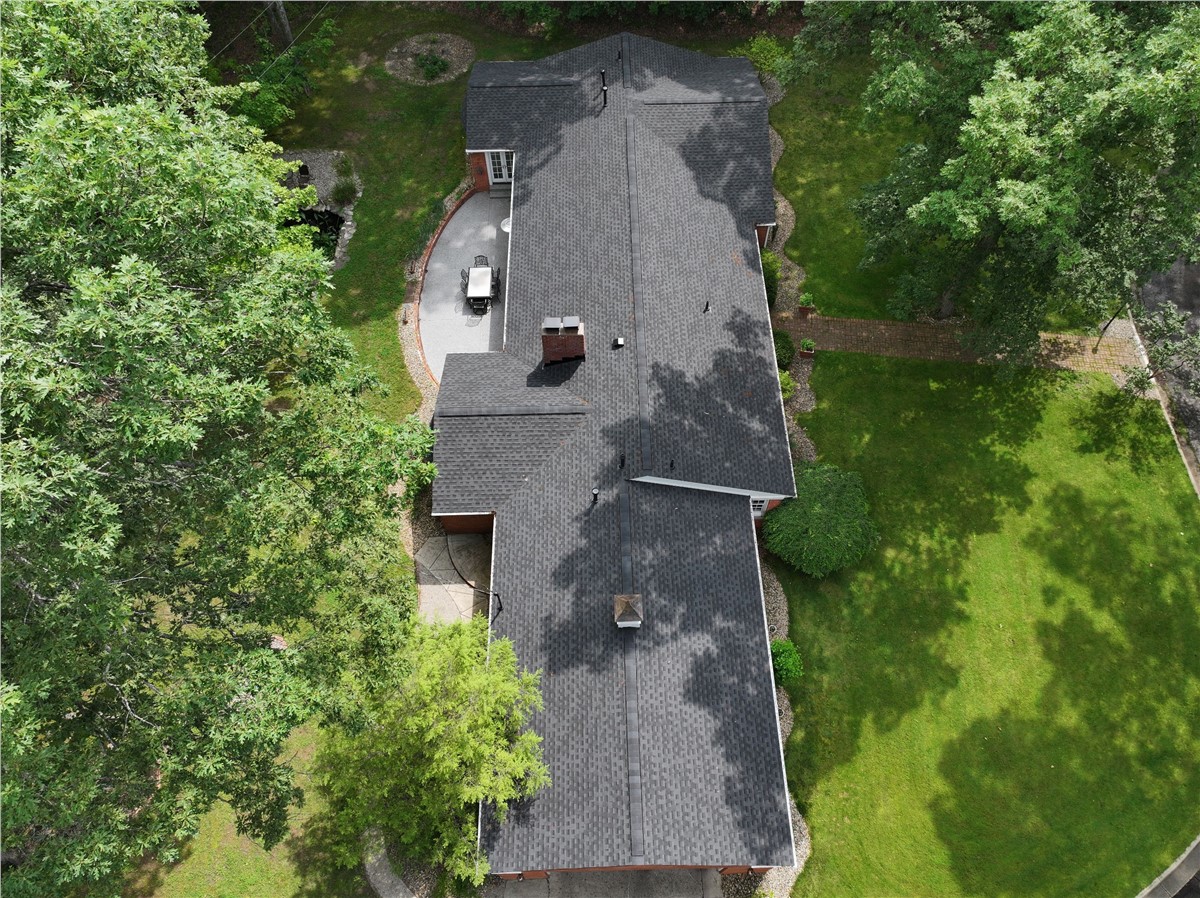We’ve all been there, a moisture condensation stain starts to appear on the ceiling, and you hope it’s only a shadow. Or pretend that it will go away. It never does, and then comes the question; what is causing this stain on the ceiling?
Several things can cause a condensation stain on your ceiling or walls. They aren’t all tied to your roof system. It can be venting or insufficient insulation in your attic. The most important thing is to find the cause before conducting any repairs. If you don’t completely remedy the problem, the stains will return and cause problems inside your home.
What Are Moisture Condensation Stains?
You will find moisture condensation stains where there is excess moisture in your home. Pinpointing the origin of the moisture may require an expert. However, there are steps that you can take as a preliminary inspection. The starting point for many ceiling stains starts with roof issues, ventilation problems, or inadequate ventilation.
Regardless of where the stains originate, they are a problem and need to be inspected immediately. The root cause could be a symptom of a problem that can cause expensive repairs.
Contact a highly-rated roofing contractor to conduct a thorough inspection of your roof system.
How Do Condensation Stains Differ From Roof Leak Stains?
Both stains are an eyesore, and you want to get both corrected quickly before a small problem becomes more significant. How are they different?
Condensation Stains
- Do not need rainfall or melting snow to form
- Are not tied to a leaky roof
- You cannot find the moisture origin
- The source of moisture is within your home
Roof Leak Stains
- Appear with rain, melting snow, and ice dams
- Caused by shingle damage, decking problems, flashing wear, and more
- You can find an entry point for water
What Causes Moisture Condensation Stains to Form?
Let’s chat about what to rule out when you see a moisture stain on your ceiling and the potential causes of condensation stains.
Rule Out The Roof
First, where is the condensation stain forming? Is it in a place where water can travel from a roof leak? Or is it in a downstairs bathroom? If it is a distance from your roof, it could be a plumbing problem instead of a roof leak.
If the leak is near the roof, inspect your attic, and check the insulation above where the stain has formed. Inspect the underside of your roof deck to look for moisture and water streaks. Water can travel so a roof leak may not be directly above your stain. However, if you are not finding any evidence of a roof leak, it may be related to condensation issues in your home.
Is There a Flashing Leak?
Inspect areas where there is flashing that you can easily access. Flashing will wear out over time and can be commonplace for a leak to form. A roofing expert should inspect all these spots as part of a complimentary inspection.
You will find flashing
- Around your chimney
- Around venting exiting your roof
- Skylights
- Any other places where there is a roof penetration
Ice Dam in the Winter
Ice dams occur when there is insufficient insulation in your attic. The air in the attic gets too warm and melts the snow on your roof. The eaves of your roof are cold because they extend past the exterior walls. It’s here where an ice dam forms. More ice and snow melts and continues to increase the size of the dam.
Water expands when it freezes. When water hits the ice dam, it expands. The dam can grow to where it can expand under your shingles.
Once the water is under your shingles, it can get your roof deck wet or create an active leak in your ceiling or walls.
To prevent ice dams from forming in the future, you will need to seal off the attic to prevent any warm air from entering. You may also need to add more insulation to keep it cool in winter.
Water Spots and No Roof Leak?
You’ve checked your attic and can’t find any roof leaks. Let’s discuss ventilation. Some appliances may be improperly vented or leak warm air into your attic. Heat loss from your living space into the attic is a root cause of condensation stains. Any mixture of these can create an environment where a condensation stain can form.
Does Your Attic Have Proper Ventilation?
If you find any condensation in your attic, then you are experiencing a ventilation issue. The culprit might be an ice dam or too warm air penetrating your attic. When there is significant condensation, take immediate steps to identify and rectify the issue.
Where Do Your Appliances Vent?
Appliance venting into an enclosed space, like your attic, is a surefire way to quickly create problems. Your attic likely has a natural venting system in place. These would be soffit vents that pull in cool air, and your ridge vent lets out hot and humid air. At no point should you rely on your passive ventilation system to remove extra hot and humid air from your appliances or bathroom. Always read up on local code to ensure that you adhere to local laws in your area. If you are unsure, talk to a certified contractor.
Cooktop Exhaust Tips
Local rules and regulations may vary on how to vent your cooktop exhaust properly, so be sure to either talk to a local contractor or read your local codes yourself. However, venting your cooktop into your attic will cause mold damage and potential rot. Air from your cooktop is always hot and humid. Furthermore, the air is greasy and leaves residue in your attic.
Dryer Venting Tips
Dryer vents may go through your attic and out the wall or roof. However, they cannot end or empty into your attic. Most local codes do not allow a dryer to empty into an attic space. Dryers expel hot and humid air, and allowing that into your enclosed attic will create damage.
Bathroom Exhaust Tips
The bathroom air is hot and humid. Proper bathroom ventilation to your local code will save you mold remediation and rotten attic space. All bathroom exhaust needs to exit outside of your home.
Steps To Prevent and Reduce Water Condensation Stains
Condensation stains are preventable. Take these steps to ensure that your home is less susceptible to condensation formation.
Limit Humidifier Usage
Winters are dry. They can dry out your home and your skin. Some alternative heating methods can exacerbate the dryness of your home (see wood pellets or wood-burning stoves).
According to the EPA, the humidity in your home should be 30% to 50%.
If your home is too humid, you may experience;
- Mold or mildew growth
- Window condensation on the inside of your windows
- Condensation stains form on your walls or ceiling
Check Your Vents
Exhaust ventilation is important. No appliances should vent into your attic space. Inspect the exhaust vents to make sure they are intact and in good working order. Establish that there isn’t any sort of blockage of the vents Some of the vents may have caulking around them, and that may wear out over time and allow warm air into your attic.
Upgrade Your Bathroom and Kitchen Exhaust Vents
Is your bathroom exhaust fan large enough to move the amount of air out of your bathroom? This article has great tips on upgrading your bathroom exhaust.
What about your cooktop exhaust?
Find out if you need a larger exhaust before visiting the home improvement store.
Have Your Attic Inspected
Your attic can be the jumping-off point for several problems that you will find in your home. Air leakage into the attic can create an environment ripe for condensation growth.
Improper ventilation, as mentioned above, can ramp up moisture problems in your attic so it’s critical to establish where your appliances vent. Hairline leaks in your plumbing may create condensation in your attic or walls. A small drip can cause condensation problems and lead to the formation of a moisture condensation stain.
How Can I Remove Moisture Condensation Stains on the Ceiling?
Once the root of your condensation problem has been repaired, then you can focus on the clean-up.
DIY Solution to Clean Moisture Condensation Stains
Supplies to Remove Ceiling Condensation Stains
- Bleach
- Spray bottle
- Rag or sponge
- Drop cloth
- Protective gloves
- Goggles
- Ladder
- Painters tape
- Stain blocking primer like Zinsser or Kilz
- Roller
- If you have a textured ceiling, use a ¾- inch to 1-¼ inch nap roller cover
- If you have a smooth ceiling, use a 3/8-inch nap roller cover
- Regular ceiling paint
Mix one cup of bleach with three cups of warm water.
- Clean the moisture condensation stain
Clean the stain using the bleach solution. Use protective gloves and goggles and wipe the stain with a rag or sponge. The bleach in the solution will help fade the stain. It will also remove any dirt, grime, and mildew. Rinse away any remaining solution with the spray bottle filled with water. Wipe dry.
2. Prime the area
Tape off the area that you are painting to make sure you don’t get paint all over the place. Covering the stain with a blocking primer will disguise the stain. Special stain-blocking paint is formulated to help hide stains. Follow the instructions on your stain-blocking primer and let dry per package instructions.
3. Paint
Use matching ceiling paint to go over the freshly primed area. If you do not have any paint left over make sure that you buy ceiling-specific paint. Ceiling paint is specially formulated for ceiling use and masks imperfections. Once the first coat has dried, apply a second coat.
Schedule a Free Roof Inspection With The National Residential Roofer of the Year
If you are experiencing condensation stains or roofing/ ventilation issues in your attic, you want to trust an expert. Feazel has diagnosed, repaired, and replaced thousands of roofs in Columbus, Cincinnati, Cleveland, Dayton, Indianapolis, and Raleigh. Our award-winning team of experts will give you a diagnosis of your roof.
Tags
Subscribe to Feazel's Blog






Comments